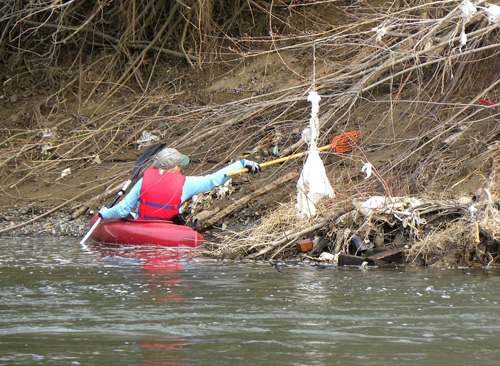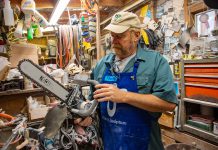
A white plastic bag decorates a bare willow branch where I live beside the Russian River. On sunny winter mornings the plastic stands out as an odd white smear against a background of green redwoods and dormant grey willows.
“It looks like an egret,” my wife said one morning. I wish it did. My wife is an artist who sees more than I do. To me it looks like what it is, litter in a tree.
There’s plastic in the trees all up and down the River this time of year, caught in the branches during high water as happened after last month’s rain when the River nearly rose to flood stage.
It happens every winter, plastic catching in the trees, blooming like freaky white flowers in February. My first instinct is to pick the trees clean but that’s not so easy to do. Two years ago this week I watched a Russian Riverkeeper crew in kayaks trying to remove thousands of pieces of plastic caught in riverside trees downstream from an old dumpsite at Korbel Champagne Cellars. It looked like a hopeless task, but that didn’t seem to faze the litter pickers, including Healdsburg resident and Riverkeeper Executive Director Don McEnhill. “Whatever we don’t get today,” said McEnhill, “we’ll get another time.”
I believe they’re still at it. One of those pulling trash out of the trees was Bob Legge, in intern with the North Coast Regional Water Quality Control Board that is working with Sonoma County, local cities and the Sonoma County Water Agency to address the problem of plastic bags polluting inland waterways and the Pacific Ocean.
The problem of preventing plastic debris from getting into the ocean is now a priority of the California Coastal Commission, which is “looking inland to see where the stuff is coming form,” said Legge.
“The Coastal Commission has set the tone for what’s expected inland,” said Legge. “The plastic is originating on land.”
At sea the plastic has created the Great Pacific Ocean Garbage Patch, a mass of mostly plastic debris thought to be about the size of Texas. The patch is floating in the horse latitudes, trapped by the currents of the Pacific gyre.
It’s not hard to imagine the Russian River contributing generously to this mess. In Sonoma County we use more than 258 million plastic carryout bags per year, which comes to about 531 bags per person, according to a draft environmental impact report that came out last week. The report was prepared to find out what might happen if single-use carryout plastic bags were banned in Sonoma County and all nine of its incorporated cities.
The proposed ordinance would apply to all retail establishments selling clothing, food, and personal items, but it would not apply to restaurants, so you could still get a plastic doggie bag to carry your leftovers.
The proposed ordinance would prohibit “the free distribution of single-use carryout paper and plastic bags“ starting this summer, and allow retailers to make recycled paper bags available for a minimum charge of ten cents apiece.
So after talking about it for five years 2013 may be the year Sonoma County joins many other California cities and counties that have either banned or otherwise restricted use of the ubiquitous single-use plastic carryout bags, most of which end up either as litter on the landscape or buried in a landfill.
The target date for the bag ban is July 1, but that may be optimistic.
“I wouldn’t put money on it,” said Patrick Carter, a department analyst with the Sonoma County Waste Management Agency, which is tasked with enforcing the ban.
People may need more time to get a grip on living without plastic, said Carter. Feedback from retailers has been light. There’s a public hearing coming up on Feb. 20 when the Waste Management Agency’s board of directors meets in Santa Rosa City Hall chambers at 9 a.m., and a 45-day comment period on the draft EIR started this week.
Why bother? What’s the big problem? “Single-use plastic carryout bags enter the biological environment primarily as litter,” says the draft EIR. “This can adversely affect terrestrial animal species, and marine species that ingest the plastic bags (or the residue of plastic bags) or become tangled in the bag. Ingested plastic bags affect wildlife by clogging animal throats and causing choking, filling animal stomachs so that they cannot consume real food, and infecting animals with toxins from the plastic.”
Based on data collected a few years ago from an Ocean Conservancy International Coastal Cleanup Day, approximately 11 percent of the debris was plastic bags.
“More than 260 wildlife species including invertebrates, turtles, fish, seabirds and mammals, have been reported to ingest or become entangled in plastic debris. Ingestion or entanglement may result in impaired movement and feeding, reduced productivity, lacerations, ulcers, and death,” according to the EIR, now available on the County Waste Management Agency’s website, www.recylcenow.org.
The proposed county ordinance would reduce plastic bag usage by approximately 95 percent.
“Several other agencies in the region (City of Millbrae, City of Fairfax, County of Santa Clara, City of San Jose, City of Sunnyvale, County of Santa Cruz, Marin County, City of San Francisco, Alameda County, San Mateo County (including 24 cities in San Mateo County and Santa Clara County), City of Palo Alto, County of Mendocino, City of Fort Bragg, and City of Ukiah) have either adopted or are considering such ordinances,” says the draft EIR.
One impact the report looks at is the potential increase in water use when more people have reusable cloth bags that have to be washed. The report assumes that half the new reusable bags, approximately 1.6 million, will get washed in a washing machine once a month.
“Once a month?” I thought, reading the report that says this monthly bag laundering will require 40 million gallons of water a year. These people haven’t seen my reusable cloth bags. They get washed about once a year, whether they need it or not. For the record.
Will the ban put plastic bag makers out of business? Some might hope. But the report doesn’t go into that. And at the moment there are no plastic bag makers in Sonoma County. Maybe that’s because they’ve been watching the cleanup efforts.
How you can help
• Russian Riverkeeper Park project in Guerneville.
Volunteers are needed to work at the Park to help restore riverbank habitat. No experience necessary. Everyone and all ages are welcome. Activities include: planting and caring for native plants, weeding, mulching, erosion control, restoration education and Park cleanup. Students can receive volunteer and internship credit for participating. Visit the park to see the transformation or be part of the transformation taking place. Light refreshments provided.
When: Every Wednesday. Event cancelled when there is enough rain to need a raincoat.
Time: 8:30 AM and 11:30 AM, please join us for all or part.
Bring: Water and gloves-wear sturdy shoes.
Where: 16153 Main St. Guerneville, located on the north bank of the Russian River directly upstream of the pedestrian bridge. Access is down a driveway west of Sonoma Nesting Co. At the bottom of the driveway look for the blue and white sign that says, Russian Riverkeeper Demonstration Riparian Restoration Project Future Community Park. Parking is available near the sign.
For more information contact Victoria Wikle at 865-2474.
• Foss Creek Restoration Project
The Foss Creek Community Restoration Project in Healdsburg is a multi-year native plant restoration project on Foss Creek that will involve removing large amounts of invasive non-native plants that have taken over parts of Foss Creek.
The project started in April 2009 and will continue through fall of 2013 on Foss Creek between the Purity Lot (North St.) and the intersection of Healdsburg Avenue, Mill Street and Vine Street behind the h2 Hotel and Chamber of Commerce.
Foss Creek Community Restoration Project Goals
— Improve wildlife habitat along Foss Creek
— Educate community on value of watershed stewardship
— Reduce flooding impacts caused by invasive non-native plants
— Increase visibility and aesthetics of Foss Creek
See the work schedule below for volunteer workdays. They meet at 8:30 a.m. at the location noted on schedule and work until 11 a.m. Riverkeeper provides tools, gloves and equipment and volunteers need to wear sturdy shoes and long pants.
2013 Foss Creek Volunteer Days – To be announced. Go to www.russianriverkeeper.com for details.








